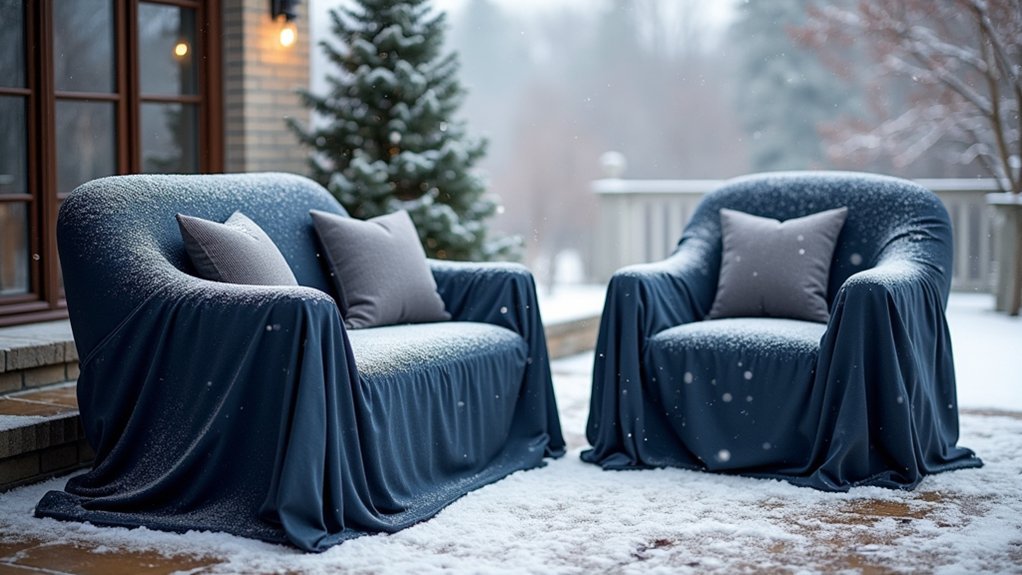You’ll maximize your patio furniture’s winter protection by choosing heavy-duty polyester or vinyl covers with UV resistance and water-repellent coatings. Guarantee proper fit with elastic hems or buckle straps, and clean furniture thoroughly before covering to prevent mold growth. Select covers with ventilation features to reduce moisture buildup, regularly remove snow to prevent sagging, and inspect weekly for tears or wear. Store covers in well-ventilated areas during off-season to maintain their effectiveness and discover additional strategies below.
Choose Weather-Resistant Materials for Maximum Protection

When winter approaches, you’ll want to invest in covers made from heavy-duty polyester or vinyl that can withstand harsh weather conditions like snow, rain, and UV rays.
Heavy-duty polyester and vinyl covers offer essential protection against snow, rain, and UV damage during harsh winter months.
These durable materials provide superior protection compared to lightweight alternatives that tear easily under harsh winter conditions.
Choose outdoor furniture covers with water-resistant coatings to prevent moisture penetration that leads to mold, mildew, and rust formation.
However, don’t sacrifice breathability for water resistance. Breathable fabrics allow proper air circulation, reducing moisture buildup beneath the covers during extended winter storage.
Look for UV protection features even in winter covers, as sun exposure can still cause fading and deterioration.
Quality weather-resistant materials should resist tearing and abrasion, ensuring your investment protects your furniture effectively throughout multiple winter seasons.
Ensure Proper Fit and Secure Fastening
You’ll need to measure your furniture’s length, width, and height precisely to select covers that fit snugly without being too tight or loose.
Look for covers with elastic hems, drawstrings, or buckle straps that’ll keep them securely attached to your furniture.
Proper fastening prevents wind from getting underneath the covers and potentially damaging both the cover and your furniture.
Measure Furniture Dimensions Accurately
Getting accurate measurements is the foundation of selecting winter patio furniture covers that’ll actually protect your outdoor pieces.
To measure furniture dimensions accurately, start by recording the full length from end to end, including protruding arms or legs, then add several extra inches for a snug fit. Measure width across seats from left to right, accounting for armrests on chairs and sofas.
Don’t forget height measurements from top surface to ground, ensuring covers designed for your specific pieces can withstand harsh weather conditions.
Consider special features like umbrella holes in patio tables and seek covers that accommodate these elements.
Always verify that your chosen covers include secure fastening mechanisms like straps or elastic hems for ideal protection during winter storms.
Select Appropriate Fastening Methods
Once you’ve measured your furniture accurately, securing your winter covers with proper fastening methods becomes essential for effective protection.
Choose covers equipped with built-in straps, buckles, or elastic hems that create snug fits and resist displacement during windy conditions. Look for adjustable features that let you customize the fit to your specific dimensions, preventing snow accumulation and gaps.
Enhance security by adding weight bags or ground anchors, particularly before storms. For extra stability, use crisscross bungee cords over the cover’s top, securing them underneath your furniture. This prevents strong winds from lifting or shifting the protection.
Inspect and adjust your fastening methods regularly to maintain tight fits. Loose covers create sagging and moisture buildup, compromising your furniture’s protection throughout winter.
Prevent Wind Displacement Issues
Strong winds pose the greatest threat to patio furniture covers, but selecting the right materials and fastening systems will keep your protection in place all winter long. Choose furniture covers with secure fastening mechanisms like buckles, straps, or drawstrings to prevent wind displacement effectively. Ascertain each cover fits snugly around your specific furniture pieces to minimize movement.
| Securing Method | Purpose | Additional Benefits |
|---|---|---|
| Weight bags | Ground anchoring | Easy repositioning |
| Drawstring closures | Tight perimeter seal | Quick adjustment |
| Buckle straps | Maximum hold strength | Long-term durability |
| Ventilation features | Air circulation | Reduce moisture buildup |
| Ground anchors | Additional stability | Permanent solution |
Regularly inspect your covers for wear or gaps that compromise security. Ventilation features prevent ballooning while maintaining protection.
Clean Furniture Thoroughly Before Covering
Before you store your patio furniture for the winter, you’ll need to give it a thorough cleaning to prevent damage during the cold months.
Clean furniture thoroughly using warm water and mild soap, paying attention to crevices where dirt accumulates. This removes debris that can trap moisture and create ideal conditions for mold and mildew growth.
After washing, allow to air dry completely before applying any protective cover. Trapped moisture causes wood rot and metal rust.
For wooden furniture, apply a sealant after cleaning for extra protection against moisture absorption.
Regular cleaning and inspection before covering doesn’t just prevent deterioration—it helps prolong lifespan and maintains your furniture’s appearance.
Taking these steps guarantees your patio pieces emerge from winter storage ready for another season.
Select Covers With Ventilation Features

You’ll want to choose covers with built-in ventilation features to prevent moisture buildup that leads to mold and mildew growth on your furniture.
Mesh vents allow air to circulate while keeping rain and snow out, ensuring your furniture stays dry throughout winter.
These ventilation systems also prevent condensation from forming under the cover, which can cause just as much damage as direct exposure to the elements.
Prevent Moisture Buildup
While many homeowners focus on waterproof materials when choosing patio furniture covers, they often overlook ventilation features that prevent moisture buildup underneath.
You’ll want to select outdoor furniture covers with breathable fabrics that allow air circulation while keeping rain and snow out. These materials prevent condensation from forming inside, which can cause rust on metal pieces or rot on wooden furniture.
Look for covers with mesh vent openings that facilitate proper ventilation without compromising protection. This airflow prevents moisture accumulation that leads to mold growth and reduces sagging from snow and ice buildup.
Throughout the winter months, you should regularly inspect these ventilation features to verify they’re functioning correctly. This simple step helps you protect your investment from moisture-related issues.
Mesh Vent Benefits
Mesh vents transform ordinary patio furniture covers into sophisticated protection systems that actively combat winter’s most destructive force: trapped moisture. Mesh vent covers feature strategic ventilation openings that promote continuous airflow, preventing moisture accumulation beneath the cover. This circulation prevents mold and mildew growth while protecting wooden furniture from rot and metal pieces from rust.
| Problem | Solution | Result |
|---|---|---|
| Trapped moisture | Mesh ventilation openings | Continuous airflow |
| Condensation buildup | Breathable fabric materials | Reduced water damage |
| Snow/ice formation | Strategic air circulation | Prevents heavy moisture |
| Furniture discoloration | Proper ventilation system | Maintains aesthetic appeal |
| Frequent maintenance | Quality vented covers | Extended furniture lifespan |
Breathable fabric minimizes condensation that causes discoloration and deterioration. You’ll extend lifespan while reducing seasonal maintenance requirements.
Regularly Remove Snow and Ice Buildup
Although winter weather can be unpredictable, you’ll need to stay vigilant about clearing snow and ice from your patio furniture covers throughout the season.
Regularly removing accumulation prevents excessive weight that causes sagging and potential damage to both covers and furniture underneath. Use a soft brush or broom to gently clear snow and ice without tearing the fabric or creating abrasions.
Clear snow buildup promptly using soft brushes to prevent cover damage and protect the furniture beneath from excessive weight.
Prompt removal isn’t just about weight concerns—it prevents moisture penetration that leads to mold and mildew growth.
You should inspect covers periodically for tears or weak spots, especially after heavy snowfall. Keep covers taut with minimal sagging to prevent water pooling, which accelerates deterioration of your furniture during harsh winter months.
Inspect and Maintain Covers Throughout Winter

Even with proper snow removal, your patio furniture covers need ongoing attention throughout winter to maintain their protective qualities.
Regular inspection and maintenance guarantee they’ll protect your furniture effectively through harsh conditions.
Follow these essential maintenance steps:
- Inspect covers weekly for tears, weak spots, or signs of wear that could compromise protection against winter elements.
- Remove covers periodically to allow furniture to breathe and check for trapped moisture that promotes mold growth.
- Clean covers monthly with mild soap and water to maintain effectiveness and prolong their lifespan.
Keep covers taut and securely fastened to prevent wind displacement during storms.
After each snow event, verify the covers haven’t shifted or loosened.
Address any moisture buildup immediately to prevent damage underneath.
Store Covers Properly During Off-Season
When winter ends and it’s time to put away your patio furniture covers, proper storage becomes essential for extending their lifespan and maintaining their protective qualities.
Before you store covers properly, clean them thoroughly to remove accumulated dirt and debris that could cause problems during storage.
Make sure your covers are completely dry before packing them away. Even small amounts of moisture can lead to mildew growth and unpleasant odors throughout the winter season.
Choose a well-ventilated area for proper storage, avoiding damp basements or sealed spaces.
Fold covers neatly without stacking heavy items on top. Use breathable storage bags rather than sealed plastic containers to maintain airflow and prevent moisture buildup that damages materials.
Frequently Asked Questions
What Is the Best Way to Cover Patio Furniture in the Winter?
Use high-quality waterproof covers made from polyester or vinyl. Confirm they fit snugly, secure with straps, clear snow regularly, choose ventilated options, and store covers properly when not using them.
Can You Leave Patio Furniture Outside in Winter if It Is Covered?
Yes, you can leave covered patio furniture outside during winter. You’ll need high-quality, weather-resistant covers that fit snugly, plus regular maintenance to remove snow buildup and check cover integrity.
Should Outdoor Furniture Covers Touch the Ground?
No, you shouldn’t let outdoor furniture covers touch the ground. You’ll prevent moisture buildup, mold growth, and ice damage by maintaining airflow underneath. Use adjustable straps or support poles to keep covers elevated.
How to Get Patio Furniture Cover to Stay On?
Use covers with built-in straps, buckles, or elastic hems for a snug fit. Add weight bags, crisscross bungee cords underneath, and choose vented covers to prevent ballooning during windy conditions.





Leave a Reply